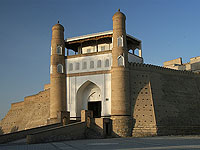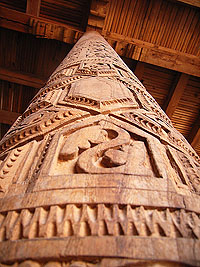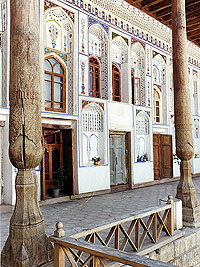 |
|
Uzbekistan - Bukhara Province |
|||||
|
Established: 1938
Area: 40,30 thousand sq. km Population: 1442,2 thousand The Bukhara province is located in central and southwestern part of the country, The province consists of 11 rural districts: OlotA Bukhara, Vobkent, Gijduvon, Jondor, Kogon, Korovulbozor, Karakul, Peshku, Romiton, Sbofirkon; 11 towns: Bukhara, Vobkent, Gazly, Galosiyo, Kogon, Olot, Gijduvon, Karakul, Romiton, Korovulbozor, Shofirkon; 3 town-type-settlements: Jondor, Zafarobod and Yangiobod; as well as 121 villages. The city of Bukhara is the administrative center of the province (616 km from Tashkent, 259,0 thousand people). Agriculture: cotton, grain crops, fruit and vegetables, silk cocoon production, cattle breeding. The territory of the province is made of hills and flatlands, the highest point of which is the Tamditau (922m), at the same time the Kyzyl Kum Desert occupies the nine tenths of the province. Some well-irrigated land is only in the south of the province, the oases of Gijduvan, Bukhara and Korakul. The climate is continental with very harsh winters. Summers are hot and dry. Water resources are limited. The main rivers are the Amu Darya and Syr Darya. The water from the Amu Daiya to the irrigated oasis is delivered through the Amu-Bukhara and Amu-Karakul canals. The cotton and cocoon are produced in Bukhara, Gijduvan and Karakul oases. The reprocessing of agricultural goods, especially cotton, is well developed. The land is very rich in natural resources, but the main resource is natural gas. Uzbekistan's major prospected and developed gas deposits are in Bukhara. Bukhara takes the lead with regard to natural gas mining, metal production, non-ferrous metallurgy and chemical industry. This is in spite of the fact that the population density in the province is the lowest in the country, with the south of the province - as an exception. Economically, the local industry and agriculture encompasses a variety of fields of industry. There is one of the largest oil refineries in Korovulbozor. The Bukhara-Khiva oil and gas strip has the largest prospected deposits of natural gas in Uzbekistan. The province is one of the major centers of fuel and power industry in Central Asia. There are factories making construction materials, grain refineries, beer and wine breweries, milk processing plants, canning factories, as well as chocolate and macaroni factories. Light industry factories produce karakul pelt and gold-knitted fabrics. There are more than 100 state owned enterprises, 13 joint ventures, 1780 small - and medium-sized enterprises, as well as 54 cooperative entities. The Uzbek-Greek "Bukhara-Omega-Furs" and "Sitora-Omega" joint ventures, Uzbek-Korean "Bukhoroi-Sharif Electronic Corporation", (color TVs), Uzbek-Bulgarian Agriculture is divided into two - the one in the south, and the livestock farming in the north. The leading crop is cotton in addition to horticulture, grapes, and cocoons. The livestock farming is mainly oriented towards milk and meat production. An additional feature of the Bukhara livestock farming is the production of karakul pelts. Karakul sheep are bred in pastures in the Kyzyl Kum Desert.
The main transportation network is the railroad (210,6 km). The total length of automobile roads is 9,820 km. The main highways are Bukhara - Turkmenistan, Bukhara - Guzar. There are 527 schools, many gymnasiums, lyceums, specialized music schools and three higher education institutions, 504 libraries, 265 clubs, 5 museums, 55 healthcare establishments, and 3 sanatoriums. Bukhara is one of the ancient cities in Central Asia. Its 2500-year anniversary was celebrated in 1997. It is on the UNESCO World Heritage list. It is such an amazing city that from the very beginning until 1920 it never expanded beyond the city walls that were constructed back in the 16th century. In the past, the city was leveled several times, but it always was able to recover and prosper.
By the 10th century Bukhara was known as the city of the developed craftsmanship and trade. Thanks to the intensified trade, supported by diplomatic relations, Bukhara became famous in Europe by the 16th century. Loud and crowded bazaars (local markets) became the hallmark of Bukhara. Trade developed along the central highways with shops on both sides. As protection from the sun in summer and from the cold in winter, a dome with hatches for light covered the main streets. Next to the trade roads were caravansaries each holding the name of countries from which the traders came: India, Russia, China, and Khorezm. Along the main streets, there were squares with magnificent madrasah and mosques. In the works of the palace poet Vasify, there is a lot of information on the cultural climate of Bukhara as well as writers, poets and scientists in Bukhara in the 16th century. Bukhara artists have left behind an amazing collection of miniatures and illustrations for books of contemporary poets and those who lived earlier. Different periods offered famous people such as Abu Abu Ali Ibn Sino (Avicena), Rudaky, Firdavsy, Imom al Bukhary, Sadriddin Ainy, Abdurauf Fitrat who lived and worked here. Bukhara is a like city-museum. It has more than 170 historical buildings and complexes. The most valuable of which is the I Mausoleum of the Samanids (late 9th - early 10th centuries), a tomb of the Samanid dynasty. It is the first known Muslim tomb in Central Asia and one of the earliest tombs in the Orient. It is also the first building in Central Asia , laid out with burnt bricks. The city's main attraction is the Minaret Kalon ('big tower', 12th century). It is the tallest architectural monument known in Central Asia (50 m). The basic planning of the city, which was designed around the geographical features of the area, has been preserved even today-The highest place was allocated to the citadel-ark, which is now a historical research museum. The Registon Square , right in front, was the place for festivities and military parades. But the most preserved architectural monument of Bukhara comes from the 16th century, the time of Bukhara as the residence and capital of ruling dynasties. Kukaldosh is one of the largest- madrasah in Bukhara. It has l60 hujras (student-rooms). Tht Nodirai Devon Begim Madrasah was originally designed and built as a caravansary, but was used as madrasah. One of the earliest madrasah is the Ulugbek Madrasah, which has been preserved up until now. On its entrance door a phrase from the Holy Koran is engraved. The Minaret called the Chor Minor, or In the 16th century Bukhara was the gathering place for the so- called wandering dervishes ('recluses'). They wandered around holy places wearing tall hats with sticks and cups in their hands, collecting donations. There were a lot of them along the roads and in cities of the Islamic East. That is why special constructions with living quarters were built next to holy places, which included a large confession hall. Fayzabad (1598/99) is one of such buildings - a shelter for wandering dervishes. In the beginning of the 20th century, the old part of Bukhara was constantly remodeled and continued to be a city full of life. New sites were added outside the medieval part of the city. Contemporary Bukhara remains a wonderful city with its wide streets lined with evergreen trees. A new city districts with tall buildings and offices was built, not forgetting the many parks and squares. Bukhara is, for the most part, a city of light and food industry. The gold embroidery and gold fabrics are part of the city's tradition. The products of local masters such as gold embroidered hats, and other items such as bags and shoes are well known even outside Uzbekistan. The one and only karakul pelt factory that belongs to fur industry is in Bukhara. The factory processes karakul sheep pelts in black, gray and golden colors, which are exported to a number of countries throughout the world. A major cotton factory, cotton and cocoon silk processing plants, a meat-processing plant, as well as light industry operate in Bukhara. 100 km northwest of Bukhara is a city called Gazly, built next to one of the major gas deposits. It is a contemporary city, which suffered devastating earthquakes in 1976 and 1984. It was gradually rebuilt, and now it is the center of the gas pipeline network from where pipelines to many parts of Uzbekistan and foreign countries start. Bukhara - History, tours, and hotels |



